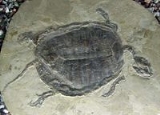
Paracryptodira
Encyclopedia
The Paracryptodira are an extinct infraorder of the Testudines, an order of reptiles which includes tortoises, turtles and terrapins. Initially treated as suborder sister to the Cryptodira
, they are now known to be a very primitive lineage inside the Cryptodira according to the most common use of the latter taxon
. Some less primitive prehistoric cryptodires (e.g. the "horned turtles", Meiolaniidae
) as well as the living forms make up the Eucryptodira.
Paracryptodires according to the obsolete concept were made up of two Cretaceous families
, the Pleurosternidae and Baenidae
. The former has been found in North America, Europe, and possibly Asia, while the latter is only known to have occurred in North America. According to modern understanding however, the Macrobaenidae and the Neurankylidae are split from the Baenidae to form the superfamily
Baenoidea, whose monophyly
needs confirmation however. In addition, there are a number of more basal families as well as some of uncertain position with regards to the Baenoidea:
The Macrobaenidae, another prehistoric cryptodiran group that may actually be a paraphyletic assemblage, are sometimes placed entirely or partly in the paracryptodires too.
. In the skull, the posterior foramen for the internal carotid canal
is located midway along the basisphenoid-pterygoid suture.
Cryptodira
Cryptodira is the taxonomic suborder of Testudines that includes most living tortoises and turtles. Cryptodira differ from Pleurodira in that they lower their necks and pull the heads straight back into the shells; instead of folding their necks sideways along the body under the shells' margins...
, they are now known to be a very primitive lineage inside the Cryptodira according to the most common use of the latter taxon
Taxon
|thumb|270px|[[African elephants]] form a widely-accepted taxon, the [[genus]] LoxodontaA taxon is a group of organisms, which a taxonomist adjudges to be a unit. Usually a taxon is given a name and a rank, although neither is a requirement...
. Some less primitive prehistoric cryptodires (e.g. the "horned turtles", Meiolaniidae
Meiolaniidae
Meiolaniidae is an extinct family of large, possibly herbivorous turtles with heavily armored heads and tails. They are best known from the last surviving genus, Meiolania, which lived in the rainforests of Australia from the Oligocene until the Pleistocene, and relict populations that lived on...
) as well as the living forms make up the Eucryptodira.
Paracryptodires according to the obsolete concept were made up of two Cretaceous families
Family (biology)
In biological classification, family is* a taxonomic rank. Other well-known ranks are life, domain, kingdom, phylum, class, order, genus, and species, with family fitting between order and genus. As for the other well-known ranks, there is the option of an immediately lower rank, indicated by the...
, the Pleurosternidae and Baenidae
Baenidae
Baenidae is an extinct family of cryptodiran turtles.-External links:* http://www.nhm.org/site/sites/default/files/dinosaur_institute/pdf/NHM_DI_proytecto_dino_Erika_Canola_Baenidae_Turtle_experience.pdf...
. The former has been found in North America, Europe, and possibly Asia, while the latter is only known to have occurred in North America. According to modern understanding however, the Macrobaenidae and the Neurankylidae are split from the Baenidae to form the superfamily
Taxonomic rank
In biological classification, rank is the level in a taxonomic hierarchy. Examples of taxonomic ranks are species, genus, family, and class. Each rank subsumes under it a number of less general categories...
Baenoidea, whose monophyly
Monophyly
In common cladistic usage, a monophyletic group is a taxon which forms a clade, meaning that it contains all the descendants of the possibly hypothetical closest common ancestor of the members of the group. The term is synonymous with the uncommon term holophyly...
needs confirmation however. In addition, there are a number of more basal families as well as some of uncertain position with regards to the Baenoidea:
- Kallokibotiidae
- Mongolochelyidae
- Pleurosternidae
- Solemydidae
The Macrobaenidae, another prehistoric cryptodiran group that may actually be a paraphyletic assemblage, are sometimes placed entirely or partly in the paracryptodires too.
Characteristics
Paracryptodira have reduced prefrontal exposure on the dorsal surface of the skull, reduced fenestra perilymphatica, and a secondary reduced supraoccipital crest.. In the skull, the posterior foramen for the internal carotid canal
Carotid canal
On the interior surface of the temporal bone, behind the rough surface of the apex, is the large circular aperture of the carotid canal, which ascends at first vertically, and then, making a bend, runs horizontally forward and medialward.-Contents:...
is located midway along the basisphenoid-pterygoid suture.

